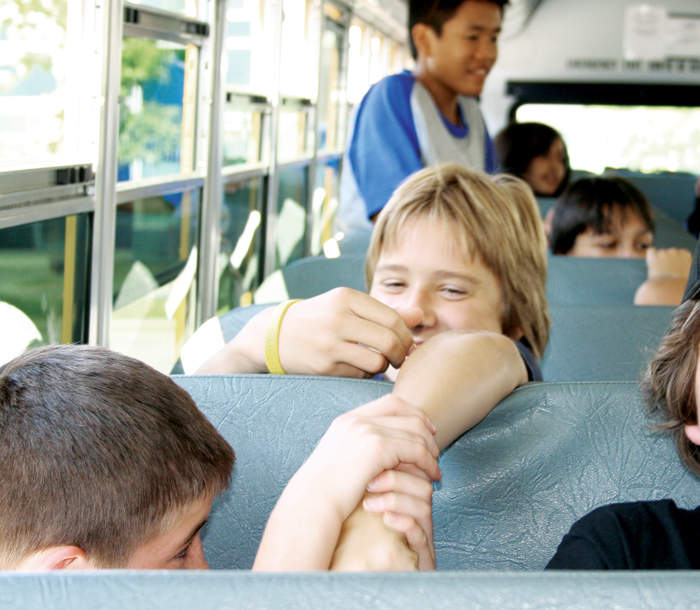 We’ve all heard the quote: “An ounce of prevention is worth a pound of cure.” Bullying can happen anywhere; on the school grounds, online, in the classroom, and often on the ride to school. Education and awareness are two great ways to prevent bullying, but where do you start? In honor of National Bullying Prevention Awareness Month, here is a starting point on your journey to keep students safe on the school bus. The following is a step-by-step guide on how to bully-proof your bus:
We’ve all heard the quote: “An ounce of prevention is worth a pound of cure.” Bullying can happen anywhere; on the school grounds, online, in the classroom, and often on the ride to school. Education and awareness are two great ways to prevent bullying, but where do you start? In honor of National Bullying Prevention Awareness Month, here is a starting point on your journey to keep students safe on the school bus. The following is a step-by-step guide on how to bully-proof your bus:
Step 1: Start with a Bullying Assessment
Stopbullying.gov, a federal government website dedicated to providing tools and resources to prevent bullying, suggests you start with an assessment of the problem through an anonymous survey. Adults can underestimate bullying because children often don’t report it.
An anonymous survey of students will help give you a clear picture of what types of bullying are actually happening on your bus and help you better target your bullying prevention and intervention efforts. Most importantly, the survey results can serve as a benchmark for measuring how well your bullying prevention programs are working.
To give you some ideas on what questions to include in the survey, download the Center for Disease Control and Prevention’s Compendium of Assessment Tools designed to help measure bullying victimization, perpetration, and bystander experiences. Another great resource is the Office of Safe and Healthy Students who published a collection of surveys to assess a school climate.
Step 2: Set Rules & Policies to Create a Safe and Respectful Environment
Creating asafe and respectful environment on the school bus can go a long way in preventing bullying. Bullying ranges from verbal taunting and name-calling to severe physical abuse. It is important to create a culture of awareness where students and drivers can easily identify and deter bullying behavior before it becomes a bigger problem.
Establish and enforce a set of rules and policies that clearly outlines how you expect students to treat one another, and publish guidelines for drivers to follow in preventing and intervening in bullying situations.
Engage students, drivers, parents, and school administrators in your policy-making and ensure that your guidelines match up with already established school rules and state laws. Once you have established your bullying policy, make sure that all stakeholders are aware of the rules and the methods for reporting incidences of bullying.
Step 3: Educate Drivers on Bullying Prevention & Intervention
Once you’ve established a set of rules & policies, the next step is educating your drivers. The school bus driver is the first and last person a child sees during the school day,and your driver’s relationship and interaction with students is a critical part of bullying prevention.
The National Association for Pupil Transportation (NAPT) in partnership with the Education Department’s Office of Safe and Drug-free Schools, and the Safe and Supportive Schools Technical Assistance Center has developed two fantastic driver training modules that provide a step-by-step trainer’s guide, a PowerPoint presentation (in PDF Format), handouts for driver activities, palm cards for drivers, and posters to display in the transportation department or throughout the school system to reinforce the messages.
Here are some links to the materials that you can download to conduct your own driver training:
Module 1: See Something. Do Something. Intervening in bullying behavior
This module teaches drivers what does and does not constitute bullying, how to respond to the behavior, and specific strategies to address and report it.
- Trainer’s Guide, Outline and Overview (PDF)
- Training Presentation (PDF)
- Handouts (PDF)
- Poster (PDF)
- Palm Card (PDF)
Module 2: Creating a Supportive Bus Climate: Preventing Bullying
Step 4: Engage Parents and Students
Remember to engage parents and students in your anti-bullying efforts. Ask parents to get involved with your campaign against bullying by watching for warning signs and having a discussion about bullying with their own children. Today’s Parent magazine recently published an article you can refer to parents as a resource –Anti-bullying 101: 14 Strategies to Squelch Bullying Tendencies in your Children.
And don’t forget about the kids! Setting expectations for how children treat one another, and creating an environment of safety and respect is essential. Educate students on your anti-bullying policy by creating kid-friendly bus rules to hand out at the beginning of the school year or post inside the bus as a reminder. For inspiration visit the Responsive Classroom to find out about their Bus Bully Project.
Step 5: Rally Community Efforts to Stop Bullying
Bullying doesn’t just happen at school. Community members can use their unique strengths and skills to prevent bullying wherever it happens. Reach out to your local community. Involve anyone who wants to learn about bullying and reduce its impact in the community. Partner with one of your local anti-bullying organizations to develop community-wide strategies to identify and support children who are bullied, redirect the behavior of bullies, and change the attitudes of adults and youth who tolerate bullying behaviors.
One organization we’ve joined is The Bully Project, a social action campaign inspired by the award-winning film BULLY. They’ve sparked a national movement to stop bullying that is transforming kids’ lives and changing a culture of bullying into one of empathy and action. Check out their web site to find a local project and get involved.
Get Started!
Getting started is half the battle, but hopefully we have given you some ideas and resources to jump-start your efforts to bully-proof your buses. We began our own journey by launching a Bullies Aren’t Cool coloring contest that has yielded results we had never even dreamed of.
Keep us posted on your journey at https://www.facebook.com/Seon.Design
Lori Jetha
Marketing Communications Manager
lori.jetha@seon.com
1.877.630.7366
seon.com


